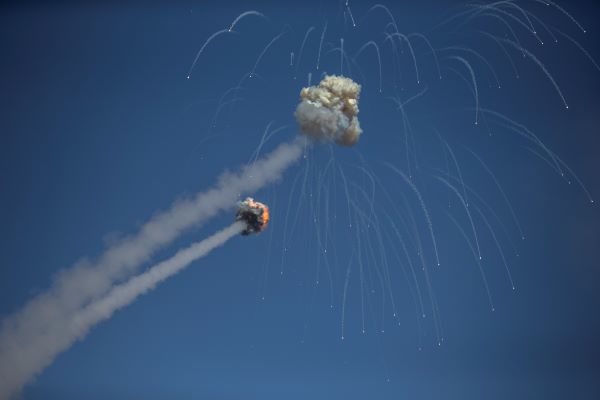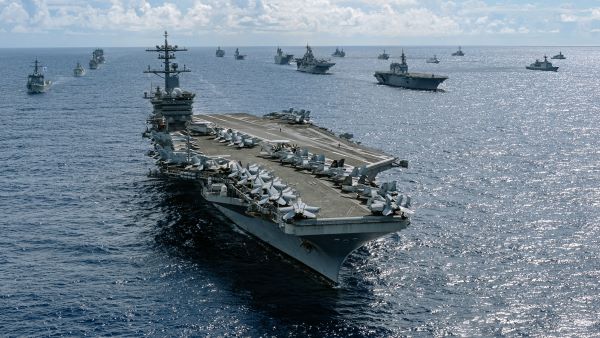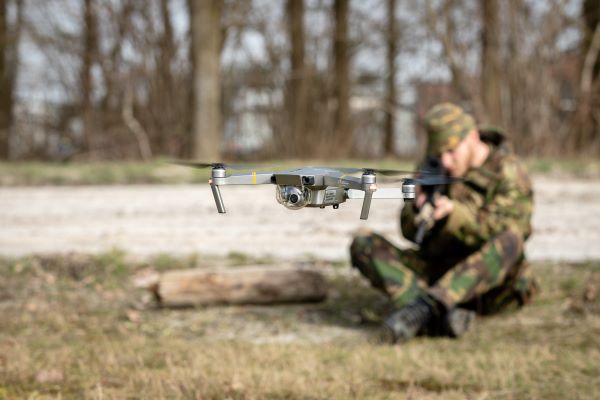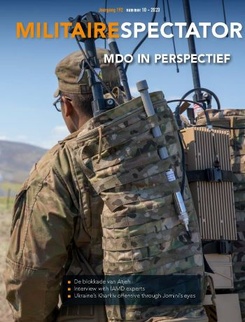North Korean missiles flying over Japan, Iranian Scuds targeting American assets in Iraq, and of course Russian aircraft, cruise and ballistic missiles and drones striking Ukraine. These potential and actual threats must be countered by a robust Integrated Air&Missile Defence (IAMD). Militaire Spectator editors spoke with several experts about geopolitics, threats, capabilities, tactics, and the latest developments in the field of IAMD.[1] As the ‘father of Israeli missile defence’ Uzi Rubin says succinctly, ‘IAMD is a strategic asset, of equal importance with nuclear weapons.’ NATO allies should pay attention to the IAMD lessons that can be learned from the war in Ukraine, and act accordingly.
Freek Groen and Maarten Katsman*
The war in Ukraine makes it clear that differentiation and mobility are key aspects of robust IAMD. Adversaries like Russia are capable of saturating air defences by using salvoes and/or swarms of various types of offensives systems, from cheap commercial drones to advanced and expensive hypersonic missiles. ‘Attacks with multiple systems from different directions and with varying speeds and altitudes force a defender to deploy various systems as well’, explains Ralph Savelsberg, who is Associate Professor Missile Defence at the Netherlands Defence Academy. The American-made Patriot system, also in use by the Dutch armed forces, ‘Is a very capable system but not against all types of targets.’ The Dutch military also has NASAMs and Stingers for medium- and short-range air defence, respectively, but ‘Integration and communication must improve and their numbers must increase’, says Savelsberg.

German and Dutch forces exercise with their Patriot missiles. What lessons about Integrated Air&Missile Defence can be learned from the war in Ukraine? Photo MCD, Hille Hillinga
Patrick Bolder, analyst at The Hague Centre for Strategic Studies (HCSS), agrees, pointing to the economic aspect of differentiation in air defences: ‘Expensive interceptor missiles should not be used to take out cheap, old Russian systems. That would lead to a form of attrition and would favour Russia because of its strength in numbers.’ Command and control and sensors are vital here, says Bolder: ‘What objects are actual threats, and what defensive system is the best equipped and cheapest to use against them?’
Beside differentiation ‘mobility is key for durable air defence’, Savelsberg adds. ‘Russia tried to eliminate Ukraine’s air defences during the initial strike in February 2022. It succeeded partly, against fixed positions, but Ukrainian forces moved a lot of systems shortly before the attack. They still do that every couple of hours or so, to great effect.’
Once sufficient IAMD is in place a defender enjoys several advantages. Bolder: ‘It creates sustainability for your own operations. And, with Ukraine in mind, protecting residential areas against aerial bombardments creates political and civil support for the defender. That is something worth considering for Western societies.’
When analysing the Russian air strikes in Ukraine, Uzi Rubin, developer of the Israeli anti-missile system Arrow, draws a comparison to the Allied bombing campaign against Germany in the Second World War. It took millions of tonnes of explosives for the Allies to make a dent in German (war) production. ‘Whereas Russia’s UAVs and cruise missiles are fairly accurate, they have too few of them to achieve similar results. Ukraine’s military machine is still functioning, including its air force and air defence. The Russians can do partial damage to Ukraine but they cannot shut it down.’
Naturally, there are more parties observing the lessons from the war in Ukraine than Russia and the West. Paul van Hooft, also analyst at think tank HCSS, noticed on recent visits to Beijing that Chinese officials acted ‘condescendingly’ with regard to Russia, which raises questions about the ‘no limits’ partnership between the two countries. ‘Because of the opaque nature of the Chinese state, it is unclear what lessons China is learning exactly’, says Van Hooft, ‘but it is telling, also to China, that the Russian air force is not very visible on the battlefield.’ He continues: ‘Ukraine demonstrates that even a relatively small state can, when supported by a major power, achieve significant results with IAMD against a much larger military force. This is not a very optimistic sign from China’s perspective, taking its ambitions towards Taiwan into account. On the other hand, Chinese leaders could also interpret this as a reason to act quickly while the West is busy with, and distracted by, the war in Ukraine.’
Geopolitics and the China question
Speaking of Taiwan, it is important not only to look at Ukraine but also ahead to the next possible conflicts, of which China’s ambition with regard to Taiwan is the obvious example. IAMD plays a strategic role in this case as well. ‘China’s goal is to push the US out of its region, and to make it hard and costly, if not impossible, for the US to carry out operations there. Missile and air defence is the prime asset, although not the only one, to achieve this goal’, says Paul van Hooft. Analysts think that the US still has the upper hand in terms of quality, its weapons systems are more advanced than China’s, but ‘in the Indo-Pacific region, the US has a limited number of “springboards” for its operations, like the islands Guam and Okinawa and, of course, the U.S. Navy’s aircraft carriers. If war breaks out over Taiwan, China will be keen on destroying those mobile and fixed assets as fast as possible to limit American combat power even further’, according to Van Hooft.
Another complicating factor in East Asia is the ‘first-mover advantage.’ Van Hooft: ‘Both sides in this potential conflict notice the importance of pro-actively neutralising the other’s IAMD capabilities to enhance both defensive and offensive operations. This is a dangerous calculation, especially when the conflict is perceived as unavoidable by one or both sides.’

USS Abraham Lincoln participates in RIMPAC, an international naval exercise in the Pacific Ocean. For China, IAMD is the primary asset to push American combat power, like aircraft carriers, out of its region. Photo U.S. Navy
Based on war games and scenarios most strategic analysts believe the US can ‘win’ a confrontation against China narrowly at best, if at all. But even if the US is defeated in, or retreats from, the East Asian region, this will not lead to territorial conquest on China’s part. That country will suffer from the same problems as the US, i.e. long distances to cover, and relative advantages for the defender. Van Hooft foresees ‘overlapping bubbles of sea denial in which IAMD plays a vital role: all the regional powers can hold each other’s offensive capabilities at gunpoint, so to speak.’
Other actors under the radar
Whereas Russia and China constitute the most prominent and immediate threats to Western security and interests, other countries also play a role in IAMD developments. Iran provides drones to Russia and has a significant (nuclear) missile programme of its own. Savelsberg notes that the ‘Iranian air force is losing effectiveness and might even become obsolete because of its aging systems.’ Therefore, ‘Iran focuses on UAVs and missiles. Especially Iran’s ballistic missiles are a force to be reckoned with, because they can attack large, static targets that always remain vulnerable, e.g. power plants.’
In fact, observers were able to study the effectiveness of Iran’s ballistic missiles because in 2020 Iran used some of them against an American military base in Iraq in retaliation of the killing of Qasem Soleimani, a top general in Iran’s Revolutionary Guard. Savelsberg: ‘Some of those missiles failed in the air, but the ones that did reach their target seem much more accurate than what we have seen before. The old-fashioned Scud is notoriously inaccurate, but the Iranian version of this missile has a CEP (circular error probable, a measure of weapons system’s precision) of only a couple of dozens of metres. That is quite impressive, especially because this is real, not just reality on paper.’
At the moment, parts of Eastern Europe are within range of Iranian missiles, but Western Europe is not. However, ‘With its space programme Iran is developing capabilities that can easily be converted to ballistic missiles with a longer range’, explains Rubin. Iran also has anti-ship missiles that can prohibit Western naval operations in the Persian Gulf. ‘If Iran wants to, it can do a lot of harm’, Rubin says. What could the West do to defend against Iranian missiles? ‘Europe is completely dependent on the US for its territorial ballistic missile defence’, says Savelsberg. There are several sea- and land-based interceptor assets in place around Europe, with command and control at Ramstein air base, but those are American capabilities. ‘It would be self-evident that European NATO allies start cooperating more to reduce their dependency on the US. Some tentative steps have been taken, like the German initiative Sky Shield, in which the Netherlands is also a participant.’
The Iranian threat has consequences for Israel’s stance in the war in Ukraine. Although Jerusalem has delivered some military aid to Ukraine, Iran’s partnership with Russia is a reason for Israel not to supply its most effective missile defence system, the Iron Dome. ‘If Iron Dome falls into Russian hands, Iran may get access to the technology. That is a severe intelligence risk for Israel’, explains Rubin. In addition, he says, ‘Within the regional geopolitical context, Israel also needs to maintain some relationship with Russia. Neutrality is beneficial in this case, providing Ukraine with Iron Dome would jeopardize that.’
North Korea recently claimed to have launched a new nuclear-capable submarine. The country is of course infamous for its missile tests, sometimes sending projectiles over Japanese territory. Savelsberg thinks that North Korea mostly uses its missile programmes to increase tensions and then receive concessions in return when it backs down. However, ‘It is disconcerting that Pyongyang adopted a new nuclear doctrine that stipulates that a first strike is an option if the regime feels its survival is under threat. In the worst-case scenario, any North Korean misinterpretation of some US moves could thus lead to nuclear attacks.’
Key developments: Quality vs quantity and IAMD’s strategic nature
The experts all raise the issue of quality vs quantity: IAMD systems can be very advanced and highly capable with a near-perfect success rate, but in the end, in a long, dragging conflict, numbers matter. Economic efficiency and quantity of systems and munitions can make the difference between losing and winning a war. Van Hooft: ‘Our current systems may be too complex and take too long to produce and replace. This counts for all aspects. For example, it takes years to build destroyers with IAMD capabilities which are not easily replaced. And the IAMD assets that they carry with them are also limited. After using a couple of missiles, the ships may have to turn around and resupply, which is detrimental to operational flexibility. Also, the ports are fixed locations and thus easy targets for the adversary. They need air defences as well. In other words: advanced, very effective systems still have limited deployability in high-intensity conflicts, which an adversary can exploit.’
When looking at the actual battlefield in Ukraine, the impact and importance of IAMD is clear. Air defence is even a crucial factor in the outcome of the war, says Rubin: ‘Russia could deploy much more air-ground assets if Ukraine lacked ground-based air defence. It keeps Russian offensive power at bay.’
Savelsberg adds a Dutch dimension: ‘For the Royal Dutch Navy integrating air defences comes naturally. A ship is an obvious target, so defending ships or task forces has always been a priority. With ground-based air defence within the Dutch armed forces, it is not always clear who is responsible and for what. For instance, should ground-based systems be integrated into manoeuvring formations or should they be deployed to defend stationary targets?’ And, Savelsberg continues, ‘At the same time, threats from the air are growing and defence against them is becoming more complex, with increasingly diverse types of systems and higher numbers of them. It is a real challenge from a financial but also from a personnel and knowledge perspective.’

A soldier practices with a counter-drone rifle. Cost-effectiveness is a key element to defend against air and missile threats. Photo MCD, Gregory Frény
Van Hooft advises Western militaries to ‘focus on quantity, cost-effectiveness and resilience and sustainability. Those factors are perhaps more important than the quality of individual systems.’ Also, ‘Western countries should focus more on creativity and refrain from falling back on the easy old patterns and solutions. UAVs, for example, have not yet turned out to be the revolution in warfare that some observers predicted, but that does not mean air forces should automatically keep investing in better versions of their traditional fighter jets.’
Bolder argues that some old concepts are actually still quite useful: ‘In a sense, NATO should return to a Cold War mentality with sectoral defences. Within the NATO alliance, “more” is the keyword: more capabilities, assets and cooperation. The upgraded enhanced Forward Presence on NATO’s Eastern flank, for example, requires more capabilities, including IAMD.’ In addition, ‘we need to rethink what position IAMD assets should take in our defence’, says Bolder. ‘Patriot systems are now being used to defend brigades on the move. That is not what they were designed for, however. Patriots are primarily useful to defend strategic targets. For battlefield protection and the defence of manoeuvring brigades other systems are required. NATO (and the Netherlands) need to rethink what systems are required to protect various potential targets.’
Uzi Rubin concurs, ‘more’ is a keyword for the West: ‘Diplomacy will buy you time, but you cannot defend yourself with diplomacy alone. We have to arm ourselves to defend basic infrastructure, and power supplies. Transportation, railways, electricity, those are the main targets for enemy air strikes.’ To conclude, the ‘father of Israeli missile defence’ places the importance of IAMD at the highest strategic level: ‘Western countries should take note: IAMD is a strategic asset, of equal importance with nuclear weapons.’
